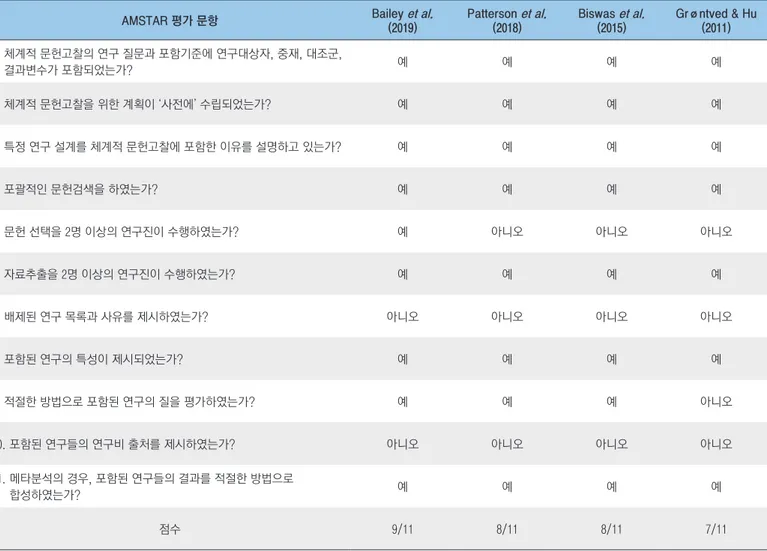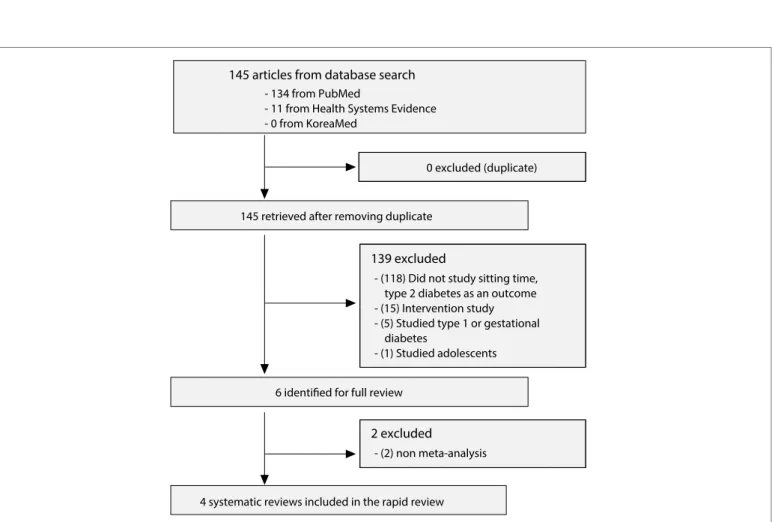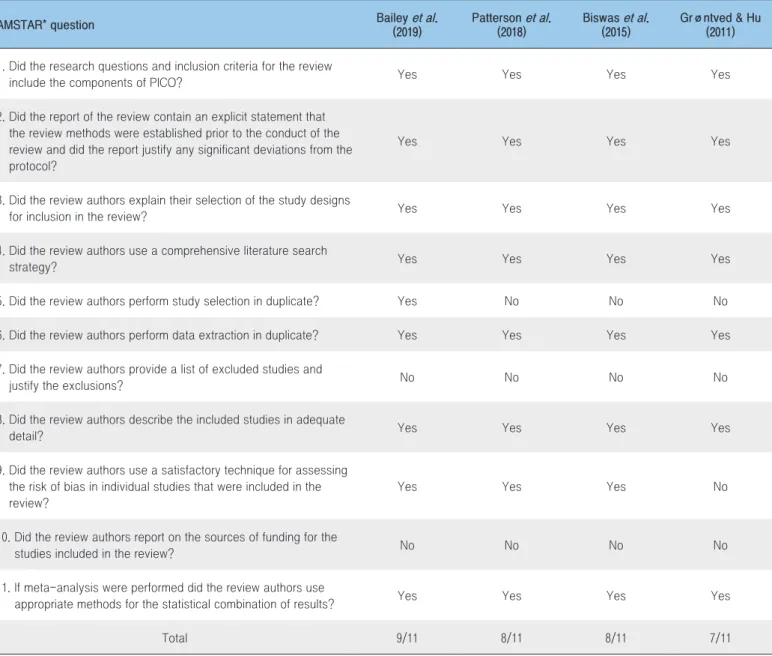앉아있는 시간과 제2형 당뇨병 발생 위험 :
신속 문헌고찰
질병관리본부 질병예방센터 만성질환예방과 송금주, 김일열* *교신저자 : k8848@korea.kr, 043-719-7430 우리나라 당뇨병의 대부분을 차지하며 주로 성인에서 생활수준의 향상으로 칼로리의 과잉섭취, 운동량 감소, 스트레스 노출에 따른 인슐린의 성능 저하 및 분비 감소로 발생하는 제2형 당뇨병을 효과적으로 예방하고 관리하기 위해서 전통적으로 규칙적인 중강도 이상의 신체활동을 강조해왔으나, 최근 신체활동 수행과 관계없이 앉아있는 시간이 긴 생활양식도 위험인자라는 연구 결과들이 보고되고 있다. 이 연구에서는 신속 문헌고찰 방법론을 적용하여 앉아있는 시간과 제2형 당뇨병 발생 위험을 보고한 총 4편의 기존 체계적 문헌고찰을 검토하였다. 연구 결과, 체계적 문헌고찰 4편 모두에서 앉아있는 시간이 길수록 제2형 당뇨병 발생 위험이 유의하게 컸으며, 크게는 1.9배까지 증가시켰다. 향후 앉아있는 시간과 관련한 구체적인 지침 수립이 필요하며, 앉아있는 시간을 줄이기 위한 국가적인 프로그램 개발과 홍보가 필요하다. 주요 검색어 : 제2형 당뇨병, 비활동적 행태, 체계적 문헌고찰초 록
들어가는 말
우리나라 만30세 이상 국민의 제2형 당뇨병 유병률은
2016년 11.3%에서 2018년 10.4%로 다소 감소하고 있는 추세이며
관리수준도 점차 향상되고 있으나, 여전히 유병자의 32%만 혈당이
조절되고 있다[1]. 혈당을 효과적으로 관리하고 나아가 제2형
당뇨병을 예방함에 있어, 규칙적인 중등도 이상의 신체활동은
필수적이지만[2], 우리나라 성인(만19세 이상)의 신체활동 실천율은
감소하고 있는 추세이다[1]. 우리나라의 연간 근로시간이 2018년도
기준 1,993시간으로 경제개발협력기구(OECD) 국가 중 두 번째로
긴데, 이러한 장시간의 근로시간과 우리 국민의 낮은 신체활동
수준은 무관하지 않을 것으로 판단된다.
당뇨병과 같은 만성질환을 예방·관리하기 위해 전통적으로
“중강도 이상의 신체활동” 수행을 강조해왔다면, 약 10여 년
전부터는 “비활동적 행태(sedentary behavior)”를 더불어 강조하기
시작했다. 비활동적 행태는 깨어있는 시간 동안에 행해지는
에너지소비량이 1.5 대사당량(metabolic equivalents, METs) 미만인
활동으로 주로 앉아있기, 누워있기, 기대어 있기로 정의하며[3],
국가별, 연구별로 차이는 있으나 대규모 코호트 연구에서는
“앉아있는 시간”과 “TV 시청 시간”으로 측정한다.
국내에서도 국민건강영양조사 데이터를 사용하여 비활동적
행태와 당뇨병[4], 인슐린 저항성[5]의 상관관계를 검증하는 연구가
수행되었으나, 연구 수가 적어 결과의 일관성을 판단하기는 어렵다.
한편 당뇨병 예방을 강조하는 차원에서 수행된 미국과 유럽의 일부
개별 연구에서는 신체활동 수행 여부와 관계없이 비활동적으로
보내는 시간이 긴 경우 당뇨병 발생 위험이 증가한다고 보고하고
있다[6]. 이에, 관련 연구들을 종합적이고 체계적으로 검토하여
“비활동적으로 보내는 시간(sedentary time)”과 당뇨병 발생 위험의
관계를 확인하고자 한다.
몸 말
1. 연구 방법
연구의 핵심 질문은 “앉아있는 시간이 제2형 당뇨병 발생률에
영향을 미치는가?”이며, 신속 문헌고찰(rapid literature review)
방법론[7]에 따라 기존 체계적 문헌고찰 및 메타분석 연구 결과를
고찰하였다. 일반 성인을 대상으로 한 연구, 전향적 코호트 연구,
추적관찰 후 당뇨병 발생(incidence)을 보고한 연구를 포함하였으며,
소아(제1형) 또는 임신성 당뇨를 보고한 연구나 중재 연구는
포함하지 않았다.
문헌 데이터베이스는 국외 2개(PubMed, Health Systems
Evidence), 국내 1개(KoreaMed)를 사용하였으며, 검색어는 “sitting
time”, “sedentary”, “diabetes”, “systematic review”,
“meta-analysis”를 조합하여 검색하였다. 영어, 한국어로 출판된 문헌만
선정하였으며, 출판연도에는 제한을 두지 않았다.
최종 선택된 체계적 문헌고찰의 비뚤림 위험(risk of bias)
평가는 AMSTAR(A Measurement Tool for Assessment of Multiple
Systematic Reviews)[8]을 사용하였다. AMSTAR은 총 11개 항목으로
구성된 체크리스트이며, 해당 문헌이 각 항목을 충족하면 1점을
부여하여 총 11점을 받게 된다. 총점 0~3점이면 “낮음”, 4~7점이면
“중등도”, 8~11점은 “높음”으로 문헌의 질을 평가할 수 있다.
2. 연구 결과
문헌 검색 전략에 따라 3개의 데이터베이스에서 검색된 연구
수는 총 145편이었으며 중복문헌은 없었다. 해당 문헌의 제목 및
초록을 검토하여 핵심질문에 부합하지 않는 연구나 연구대상,
데이터베이스(3개) 검색을 통해 확인된 145편 중복문헌 제거 후 145편 제목 · 초록 검토 총 4편의 체계적 문헌고찰 확인 - 134 PubMed- 11 Health Systems Evidence - 0 KoreaMed 1차 배제(n=139) - (118) 비활동적 시간, 제2형 당뇨병을 다루지 않음 - (15) 중재연구 - (5) 제1형 또는 임신성 당뇨병 연구 - (1) 청소년 대상 연구 2차 배제(n=2) - (2) 메타분석을 수행하지 않음 중복문헌 제외(n=0) 1차 배제 기준으로 제거 후 6편 전문(full-text) 검토
그림 1. 문헌선정 흐름도
연구설계가 맞지 않는 연구(n=139)를 일차적으로 제외하였고, 남은
6편의 연구는 전문(full-text)을 확인하여 메타분석 결과가 보고된
4편[9-12]을 최종 선택하였다(그림 1).
최종 선택된 4편의 체계적 문헌고찰에 대한 AMSTAR
평가 결과는 표 1에 제시하였다. 공통적으로 배제연구 목록과
배제 사유를 밝히지 않았고, 포함된 연구들의 연구비 출처를
표 1. 체계적 문헌고찰의 질 평가(AMSTAR* 적용)
AMSTAR 평가 문항 Bailey et al.
(2019) Patterson et al. (2018) Biswas et al. (2015) Grøntved & Hu (2011) 1. 체계적 문헌고찰의 연구 질문과 포함기준에 연구대상자, 중재, 대조군, 결과변수가 포함되었는가? 예 예 예 예 2. 체계적 문헌고찰을 위한 계획이 ‘사전에’ 수립되었는가? 예 예 예 예 3. 특정 연구 설계를 체계적 문헌고찰에 포함한 이유를 설명하고 있는가? 예 예 예 예 4. 포괄적인 문헌검색을 하였는가? 예 예 예 예 5. 문헌 선택을 2명 이상의 연구진이 수행하였는가? 예 아니오 아니오 아니오 6. 자료추출을 2명 이상의 연구진이 수행하였는가? 예 예 예 예 7. 배제된 연구 목록과 사유를 제시하였는가? 아니오 아니오 아니오 아니오 8. 포함된 연구의 특성이 제시되었는가? 예 예 예 예 9. 적절한 방법으로 포함된 연구의 질을 평가하였는가? 예 예 예 아니오 10. 포함된 연구들의 연구비 출처를 제시하였는가? 아니오 아니오 아니오 아니오 11. 메타분석의 경우, 포함된 연구들의 결과를 적절한 방법으로 합성하였는가? 예 예 예 예 점수 9/11 8/11 8/11 7/11
* A Measurement Tool for Assessment of Multiple Systematic Reviews[8]
표 2. 선택문헌의 특성
연구(연도) 포함연구 수 대상자 수 추적관찰 기간(연) 비활동적 시간 측정 방법 비활동적 시간의 정의 연구수행 국가 Bailey et al. (2019)[9] 5 223,871 2.7~13.0 자기기입 앉아있는 시간 노르웨이, 미국, 호주, 영국, 덴마크 Patterson et al. (2018)[10] 4 217,724 3.4~11.1 자기기입 앉아있는 시간 호주, 미국, 덴마크 Biswas et al. (2015)[11] 5 26,700 1~10 자기기입 TV 시청 시간 호주, 미국, 독일 Grøntved & Hu (2011)[12] 4 175,938 6~10 자기기입 TV 시청 시간 미국, 독일제시하지 않았으나 전반적으로 중등도 이상의 질을 가진 체계적
문헌고찰이었다.
선택 문헌의 일반적 특성은 표 2에 제시하였다. 4편의 체계적
문헌고찰 모두 10년 이내에 출간되었으며, 포함된 개별 연구 수는
4~5편이었다. 참여자 수는 26,700명에서 223,871명이었으며,
추적관찰 기간은 1년에서 13.0년으로 다양했다. 비활동적으로 보내는
시간은 두 편의 문헌이 “앉아있는 시간”, 다른 두 편은 “TV 시청
시간”으로 정의했으며, 자기기입식(self-reported)으로 측정되었다.
연구수행국가는 미국과 영국, 호주, 독일, 노르웨이, 덴마크였다.
4편의 체계적 문헌고찰에서 비활동적으로 보내는 시간은
신체활동(또는 운 동)을 보정한 후에도, 제2형 당뇨병 발생
위험을 유의하게 높이는 것으로 보고되었다(표 3). 비활동적으로
보내는 시간을 “앉아있는 시간”과 “TV 시청 시간”으로 나누어
보면, “앉아있는 시간”이 긴 사람은 그렇지 않은 사람에 비해
제2형 당뇨병 발생 위험도가 1.01(Relative risk; 95% 신뢰구간,
1.00-1.01)에서 1.10(Hazard ratio; 95% 신뢰구간, 1.01-1.19)
높은 것으로 나타났다[9,10]. “TV 시청 시간”은 시청 시간이 긴
사람이 그렇지 않은 사람보다 제2형 당뇨병 발생 위험도(HR)가
1.20(95% 신뢰구간, 1.14-1.27)에서 1.91(95% 신뢰구간, 1.64-2.22)
높은 것으로 나타났다[11,12]. 각 문헌고찰에서 보고한 문헌 간의
이질성(heterogeneity=I
2)은 0%~50.4%로 크지 않았다.
맺는 말
총 4편의 체계적 문헌고찰 수행 결과, 신체활동 수행 여부와
상관없이 앉아있는 시간이 길수록 제2형 당뇨병 발생 위험도는
크게는 1.9배까지 유의하게 증가시켰다. 즉, 바쁜 일상 중에 시간을
내어 중강도 이상의 신체활동을 한다고 하더라도, 평소 앉아있는
시간이 길면 제2형 당뇨병 발생 위험으로부터 안전하지 않다고
해석할 수 있다.
비활동적 행태와 관련한 국가 수준의 신체활동지침(physical
activity guidelines)은 우리나라를 포함, 미국과 영국 등에서 공표된
바 있다. 미국[13]과 영국[14]의 경우, 비활동적으로 보내는 시간을
줄이라고 권고하고 있으나 구체적인 시간을 제시하고 있지 않다.
우리나라[15]의 경우 하루 2시간 이내로 줄이는 것이 좋다고
권고하고 있고, 미국 당뇨병학회(American Diabetes Association)는
30분마다 자리에서 일어나 가벼운 활동을 하도록 권고하고 있으나
근거의 수준은 낮다[16]. 하루에 몇 번이나 자리에서 일어나야
하는지, 몇 시간까지는 앉아있어도 건강에 문제가 없는지와 관련한
근거의 축적이 필요하다[17].
최근 서구에서는 앉아있는 시간이 긴 사무직 근로자에게
서서 일하는(sit-stand desk) 등의 직장 환경을 만드는 시도를 하고
있으며, 이러한 직장 환경의 변화가 공복혈당 개선에 효과적이라는
임상 연구들[18,19]도 보고되었다. 앉아있는 시간을 줄이려는 개인의
노력도 필요하지만, 정부 차원의 프로그램 개발과 적극적인 홍보를
통해 당뇨병과 같은 만성질환을 효과적으로 예방·관리하는 노력이
필요한 시점이다.
표 3. 비활동적으로 보내는 시간과 제2형 당뇨병 발생 위험
연구(연도) 발생 위험도(Hazard Ratio) 95% 신뢰구간 이질성(I2,%)
Bailey et al.(2019) 1.10 1.01-1.19 38
Patterson et al.(2018) 1.01* 1.00-1.01 0
Biswas et al.(2015) 1.91 1.64-2.22 0
Grøntved & Hu(2011) 1.20 1.14-1.27 50.4
① 이전에 알려진 내용은?
만30세 이상 국민의 제2형 당뇨병 예방과 관리를 위해
중강도 이상의 신체활동은 필수적이며, 국가적 수준의 당뇨병
진료지침과 신체활동지침에서 이를 권고하고 있다. 그러나
직업적으로나 여가시간에 앉아있는 시간이 긴 비활동적인
생활행태도 당뇨병의 위험인자라는 개별 연구가 최근 보고되고
있다.
② 새로이 알게 된 내용은?
기존에 출간된 체계적 문헌고찰에 대한 종합적 검토를
통해, 신체활동 수행 유무와 상관없이 앉아있는 시간이 길수록
당뇨병 발생위험이 유의하게 증가하며, 크게는 1.9배까지
증가한다는 사실을 확인했다.
③ 시사점은?
근무시간이 긴 우리나라의 경우 국가 보건정책적 차원에서
앉아있는 시간을 줄이는 프로그램을 개발·홍보하여 직장환경을
개선하는 노력이 필요하다.
참고문헌
1. 질병관리본부. 2018 국민건강통계. 국민건강영양조사 제7기 3차년도. 2019. 2. 대한의학회·질병관리본부. 나와 가족을 위한 당뇨병 예방과 관리 정보. 2016. 1.3. Proper KI, Singh AS, van Mechelen W, Chinapaw MJM. Sedentary behaviors and health outcomes among adults. Am J Prev Med. 2011;40:174-182.
4. 오연희, 김선미, 최윤선, 김은혜, 김이연, 김정원, 박영호. 한국인의 하 루 중 앉 아 있 는 시 간과 만성 질 환 과 의 상 관 관계 : 제 6 기 1 차 국민건강영양조사. 가정의학회지. 2016;6(1):32-36.
5. Kim KS, Kim SJ, Kim S, Choi D-W, Ju YJ, & Park E-C. Association of self-reported sedentary time with insulin resistance among Korean adults without diabetes mellitus: a cross-sectional study.
BMC Public Health. 2018;18:1335.
6. van Uffelen JGZ, Wong J, Chau JY, van der Ploeg HP, Riphagen I, Gilson ND, ... Brown WJ. Occupational sitting and health risks. A systematic review. Am J Prev Med. 2010;39(4):379-388.
7. 김수영, 신승수, 서현주, 이수정. 신속 문헌고찰 방법론 매뉴얼. 2017. 12. 8. Shea BJ, Hamel C, Wells GA, Bouter LM, Kristjansson E, Grimshaw
J, Boers M. AMSTAR is a reliable and valid measurement tool to assess the methodological quality of systematic review. J Clin Epidemiol. 2009;62(10):1013-1020.
9. Bailey DP, Hewson DJ, Champion RB, Sayegh SM. Sitting time and risk of cardiovascular disease and diabetes: a systematic review and meta-analysis. Am J Prev Med. 2019;57(3):408-416.
10. Patterson R, McNamara E, Tainio M, de Sá TH, Smith AD, Sharp SJ, Wijndaele K. Sedentary behaviour and risk of all-cause, cardiovascular and cancer mortality, and incident type 2 diabetes: a systematic review and dose response meta-analysis. Eur. J. Epidemiol. 2018;33:811-829.
11. Biswas A, Oh PI, Faulkner GE, Bajaj RR, Silver MA, Mitchell MS, & Alter DA. Sedentary time and its association with risk for disease incidence, mortality, and hospitalization in adults. Ann Intern Med. 2015;162:123-132.
12. Grøntved A & Hu FB. Television viewing and risk of type 2 diabetes, cardiovascular disease, and all-cause mortality. JAMA. 2011;305(23):2448-2455.
13. U.S. Department of Health and Human Services. Physical activity guidelines for Americans, 2nd edition. 2018.
14. The UK Chief Medical Officers. UK chief medical officers’ physical activity guidelines. 2019.9.
15. 보건복지부. 한국인을 위한 신체활동 지침서. 2013. 10.13.
16. Colberg SR, Sigal RJ, Yardely JE, Riddell MC, Dunstan DW, Dempsey PC, Tate DF. Physical activity/exercise and diabetes: a position statement of the American Diabetes Association. Diabetes Care. 2016;39:2065-2079.
17. Katzmarzyk P, Powel K, Jakicic J, Troiano R, Piercy K, & Tennant B. Sedentary behavior and health: update from the 2018 physical activity guidelines advisory committee. Journal of American College of Sports Medicine. 2019; 51(6):1227-1241.
18. Mantzari E, Galloway C, Wijndaele K, Brage S, Griffin SJ, & Marteau TM. Impact of sit-stand desks at work on energy expenditure, sitting time and cardio-metabolic risk factors: multiphase feasibility study with randomized controlled component. Prev Med Rep. 2019;13:64-72.
19. Pronk NP, Katz AS, Lowry M, & Payfer JR. Reducing occupational sitting time and improving worker health: the Take-a-Stand project.
Prolonged Sitting Time and the Risk of Type 2 Diabetes : Rapid literature review
Song Geumju, Kim Il-yeolDivision of Chronic Disease Prevention, Center for Disease Prevention, KCDC
Moderate to vigorous physical activity has conventionally been emphasized to prevent and manage type 2 diabetes; however, recent studies showed that sedentary behaviors such as prolonged sitting time is a behavioral risk factor for type 2 diabetes regardless of the level of physical activity. In order to examine the association between prolonged sitting time and the incidence of type 2 diabetes, four published systematic review studies were reviewed using a rapid literature review method. Study results showed that prolonged sitting time significantly increased the risk of type 2 diabetes. Physical activity guidelines including a specific sitting time with scientific evidence will be needed. Furthermore, the development and promotion of a national level program to reduce sitting time will be needed to prevent and manage type 2 diabetes effectively.
Keywords: Type 2 diabetes mellitus, Sedentary behavior, Systematic review
145 articles from database search
145 retrieved after removing duplicate
4 systematic reviews included in the rapid review - 134 from PubMed
- 11 from Health Systems Evidence - 0 from KoreaMed
139 excluded
- (118) Did not study sitting time, type 2 diabetes as an outcome - (15) Intervention study
- (5) Studied type 1 or gestational diabetes
- (1) Studied adolescents
2 excluded
- (2) non meta-analysis 0 excluded (duplicate)
6 identified for full review
Table 1. Results of quality of assessment of multiple systematic reviews selected using AMSTAR
AMSTAR* question Bailey et al.(2019) Patterson et al.(2018) Biswas et al.(2015) Grøntved & Hu(2011) 1. Did the research questions and inclusion criteria for the review
include the components of PICO? Yes Yes Yes Yes
2. Did the report of the review contain an explicit statement that the review methods were established prior to the conduct of the review and did the report justify any significant deviations from the protocol?
Yes Yes Yes Yes
3. Did the review authors explain their selection of the study designs
for inclusion in the review? Yes Yes Yes Yes
4. Did the review authors use a comprehensive literature search
strategy? Yes Yes Yes Yes
5. Did the review authors perform study selection in duplicate? Yes No No No
6. Did the review authors perform data extraction in duplicate? Yes Yes Yes Yes
7. Did the review authors provide a list of excluded studies and
justify the exclusions? No No No No
8. Did the review authors describe the included studies in adequate
detail? Yes Yes Yes Yes
9. Did the review authors use a satisfactory technique for assessing the risk of bias in individual studies that were included in the review?
Yes Yes Yes No
10. Did the review authors report on the sources of funding for the
studies included in the review? No No No No
11. If meta-analysis were performed did the review authors use
appropriate methods for the statistical combination of results? Yes Yes Yes Yes
Total 9/11 8/11 8/11 7/11
Table 2. Characteristics of multiple systematic reviews selected
Study (year) studies includedNumber ofNumber of participants of individual studies Follow-up period (year) Measurement of sitting time Definition of sitting time Country where the study was
conducted
Bailey et al.
(2019) 5 223,871 2.7-13 Self-reported Total sitting time
Norway, USA, Australia, UK
Denmark
Patterson et al.
(2018) 4 217,724 3.4-11.1 Self-reported Total sitting time
Australia, USA, Denmark Biswas et al. (2015) 5 26,700 1-10 Self-reported Television watching time Australia, USA, Germany Grøntved & Hu (2011) 4 175,938 6-10 Self-reported Television watching
time USA, Germany
Table 3. Sitting time and the risk of type 2 diabetes from multiple systematic reviews selected
Study (year) Hazard ratio confidence interval 95% Heterogeneity(I2, %)
Bailey et al. (2019) 1.10 1.01-1.19 38%
Patterson et al. (2018) 1.01* 1.00-1.01 0
Biswas et al. (2015) 1.91 1.64-2.22 0
Grøntved & Hu (2011) 1.20 1.14-1.27 50.4



